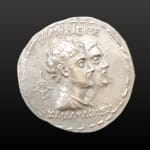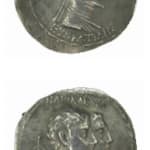Bactrian Tetradrachm of Eukratides I, 171 BC - 145 BC
Silver
Diam. 3.1 cm
Diam. 1 1/4 in
Wt. 16 g
Wt. 1/2 oz
Diam. 1 1/4 in
Wt. 16 g
Wt. 1/2 oz
LC.019
Further images
Obverse: Eukratides I facing right, wearing a crested Boeotian helmet. Inscr.: ΒΑΣΙΛΕΥΣ ΜΕΓΑΣ ΕΥΚΡΑΤΙΔΗΣ Reverse: jugate portraits of Heliokles and Laodike, facing right. Inscr: ΗΛΙΟΚΛΕΥΣ ΚΑΙ ΛΑΟΔΙΚΗΣ, Monogram: ΦΛ. Born...
Obverse: Eukratides I facing right, wearing a crested Boeotian helmet. Inscr.: ΒΑΣΙΛΕΥΣ ΜΕΓΑΣ ΕΥΚΡΑΤΙΔΗΣ
Reverse: jugate portraits of Heliokles and Laodike, facing right. Inscr: ΗΛΙΟΚΛΕΥΣ ΚΑΙ ΛΑΟΔΙΚΗΣ, Monogram: ΦΛ.
Born around 204 BC in the Hellenised city of Ai-Khanoum, Afghanistan, little is known about Eukratides I’s early life, other than the fact that he was a member of the deposed Diodotid Dynasty. The Diodotids – named for their founder Diodotos I – were the founding kings of the Graeco-Bactrian Kingdom, and had been overthrown by Euthydemos I around 225 BC. It is possible that the second Diodotid King, Arsakes, had courted the disfavour of his people by aligning with the Seleukids; a reversal of policy under his son Diodotos II seems not to have saved the dynasty, despite the legendary defence of the Kingdom against Seleukos II (Justin Historia Philippae 41.4). The resentment of the surviving Diodotids can only be imagined. It seems that they retained some support in Ai-Khanoum, which was besieged in 225 BC and may be the site of the Diodotos II’s last stand before his murder. While the powerful Euthydemid monarch Demetrios I was away conquering northern India, Eukratides gathered support and dethroned Demetrios’ relatives, who appear to have ruled as co-monarchs in Demetrios’ absence. In the ensuing chaos, the Parthians under Mithridates I attempted to conquer Bactria itself. Eukratides repelled the invasion, and went campaigning to secure the western and southern borders, probing deep into India. According to the single remaining source, the Roman historian Justin, Eukratides was not yet rid of resistance, and was besieged by one ‘Demetrios, King of India’ (Demetrii, regis Indorum), who was almost certainly not Demetrios I, but rather his eventual successor Menander. Eukratides apparently sortied from his fortress with a force of around three hundred men; they reportedly killed sixty thousand of the enemy, thus securing his rule in Bactria (Justin Historia Phillippae 41.6). In the same passage, Justin reports that Eukratides was murdered on his return from India, he says by his own son Heliokles, but more likely by Demetrios II, the son of Demetrios I.
Eukratides was a great minter of coins, producing a number of remarkable issues, including a gold 20-stater (169.2 g, 6 oz) which was the largest ever produced in antiquity (Bibliothèque nationale de France BNF41759042). Another of his unusual issues is the coin presented here: a so-called pedigree coin, depicting the King on one side, and the conjoined or jugate portraits of his parents Heliokles and Laodike. The obverse of the coin depicts Eukratides, a self-consciously martial monarch, wearing the Boeotian helmet, a common headpiece of Hellenistic warriors, and which was closely associated with the armies of Alexander the Great. The distinctive round crown and brim with a fold is complemented by a small horse-hair crest, an unusual addition to the Boeotian ensemble. With square jutting chin, pointed nose, and stern expression, Eukratides here sets forth his image as a ruler with a clear military attitude. An inscription reads basileus megas Eukratidēs, ‘the Great King Eukratides’, in the nominative case, i.e. as a label for the portrait. The appellation ‘Great King’ was an innovation of Eukratides’ reign, elevating him above the Euthymedid Dynasty (whose monarchs labelled themselves just as ‘King’, basileos), and assimilating himself to Alexander the Great, who was proclaimed Great King upon his defeat of the Persian Empire (whose own monarchs were called shahanshah, ‘King of Kings’).
On the reverse – though, it should be noted that the designation of obverse and reverse of this issue is hotly debated, with important implications for the interpretation of the coin – are jugate portraits of Heliokles and Laodike. This otherwise unknown couple are commonly thought to be Eukratides’ parents, largely on the basis that Laodike (the rearmost of the two portraits) is depicted with a small diadem. Both portraits depict manly, foreboding figures, with large eyes, straight noses and prominent chins. Alas, in Hellenistic numismatic portraits, the faces of women do not come out flatteringly. The rejection of divine beauty in favour of portraits which reveal their subjects ages, however, boosts the likelihood that these are meant to be interpreted as the parents of the King, and thus ‘grandparents’ of the nation. The reverse bears an inscription Hēliokleus kai Laodikē, ‘of Heliokles and Laodike’. On most Hellenistic coins, the use of names in the genitive (i.e. implying possession) commonly identifies those individuals as the authority under whom the coin was minted, with the implied reading ‘[this is the coin] of Demetrios’, for example. However, it is evident that Eukratides was the authority, not his parents. Given the rarity of Hellenistic coins with inscriptions on both faces, historians have been unsure how the two inscriptions relate. One popular interpretation involves reading both inscriptions together, and interpolating the word huios, ‘son’, between them, so that the whole would read ‘the Great King Eukratides, [son] of Heliokles and Laodike’. Given that Eukratides came from the deposed Diodotid line, this coin must represent an attempt of the new King to bolster his legitimacy by playing on his ancestry from Bactria’s first monarchs. The reverse also bears a monogramic mark, with the Greek letters phi and lambda.
References: examples of this rare issue can be found in London (British Museum 1888,1208.159). Drachms with the same jugate busts also exist (British Museum 1872,0709.357).
Reverse: jugate portraits of Heliokles and Laodike, facing right. Inscr: ΗΛΙΟΚΛΕΥΣ ΚΑΙ ΛΑΟΔΙΚΗΣ, Monogram: ΦΛ.
Born around 204 BC in the Hellenised city of Ai-Khanoum, Afghanistan, little is known about Eukratides I’s early life, other than the fact that he was a member of the deposed Diodotid Dynasty. The Diodotids – named for their founder Diodotos I – were the founding kings of the Graeco-Bactrian Kingdom, and had been overthrown by Euthydemos I around 225 BC. It is possible that the second Diodotid King, Arsakes, had courted the disfavour of his people by aligning with the Seleukids; a reversal of policy under his son Diodotos II seems not to have saved the dynasty, despite the legendary defence of the Kingdom against Seleukos II (Justin Historia Philippae 41.4). The resentment of the surviving Diodotids can only be imagined. It seems that they retained some support in Ai-Khanoum, which was besieged in 225 BC and may be the site of the Diodotos II’s last stand before his murder. While the powerful Euthydemid monarch Demetrios I was away conquering northern India, Eukratides gathered support and dethroned Demetrios’ relatives, who appear to have ruled as co-monarchs in Demetrios’ absence. In the ensuing chaos, the Parthians under Mithridates I attempted to conquer Bactria itself. Eukratides repelled the invasion, and went campaigning to secure the western and southern borders, probing deep into India. According to the single remaining source, the Roman historian Justin, Eukratides was not yet rid of resistance, and was besieged by one ‘Demetrios, King of India’ (Demetrii, regis Indorum), who was almost certainly not Demetrios I, but rather his eventual successor Menander. Eukratides apparently sortied from his fortress with a force of around three hundred men; they reportedly killed sixty thousand of the enemy, thus securing his rule in Bactria (Justin Historia Phillippae 41.6). In the same passage, Justin reports that Eukratides was murdered on his return from India, he says by his own son Heliokles, but more likely by Demetrios II, the son of Demetrios I.
Eukratides was a great minter of coins, producing a number of remarkable issues, including a gold 20-stater (169.2 g, 6 oz) which was the largest ever produced in antiquity (Bibliothèque nationale de France BNF41759042). Another of his unusual issues is the coin presented here: a so-called pedigree coin, depicting the King on one side, and the conjoined or jugate portraits of his parents Heliokles and Laodike. The obverse of the coin depicts Eukratides, a self-consciously martial monarch, wearing the Boeotian helmet, a common headpiece of Hellenistic warriors, and which was closely associated with the armies of Alexander the Great. The distinctive round crown and brim with a fold is complemented by a small horse-hair crest, an unusual addition to the Boeotian ensemble. With square jutting chin, pointed nose, and stern expression, Eukratides here sets forth his image as a ruler with a clear military attitude. An inscription reads basileus megas Eukratidēs, ‘the Great King Eukratides’, in the nominative case, i.e. as a label for the portrait. The appellation ‘Great King’ was an innovation of Eukratides’ reign, elevating him above the Euthymedid Dynasty (whose monarchs labelled themselves just as ‘King’, basileos), and assimilating himself to Alexander the Great, who was proclaimed Great King upon his defeat of the Persian Empire (whose own monarchs were called shahanshah, ‘King of Kings’).
On the reverse – though, it should be noted that the designation of obverse and reverse of this issue is hotly debated, with important implications for the interpretation of the coin – are jugate portraits of Heliokles and Laodike. This otherwise unknown couple are commonly thought to be Eukratides’ parents, largely on the basis that Laodike (the rearmost of the two portraits) is depicted with a small diadem. Both portraits depict manly, foreboding figures, with large eyes, straight noses and prominent chins. Alas, in Hellenistic numismatic portraits, the faces of women do not come out flatteringly. The rejection of divine beauty in favour of portraits which reveal their subjects ages, however, boosts the likelihood that these are meant to be interpreted as the parents of the King, and thus ‘grandparents’ of the nation. The reverse bears an inscription Hēliokleus kai Laodikē, ‘of Heliokles and Laodike’. On most Hellenistic coins, the use of names in the genitive (i.e. implying possession) commonly identifies those individuals as the authority under whom the coin was minted, with the implied reading ‘[this is the coin] of Demetrios’, for example. However, it is evident that Eukratides was the authority, not his parents. Given the rarity of Hellenistic coins with inscriptions on both faces, historians have been unsure how the two inscriptions relate. One popular interpretation involves reading both inscriptions together, and interpolating the word huios, ‘son’, between them, so that the whole would read ‘the Great King Eukratides, [son] of Heliokles and Laodike’. Given that Eukratides came from the deposed Diodotid line, this coin must represent an attempt of the new King to bolster his legitimacy by playing on his ancestry from Bactria’s first monarchs. The reverse also bears a monogramic mark, with the Greek letters phi and lambda.
References: examples of this rare issue can be found in London (British Museum 1888,1208.159). Drachms with the same jugate busts also exist (British Museum 1872,0709.357).
115
of
115







